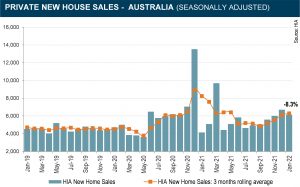 Sales of new detached homes recorded an exceptionally strong quarter, led by Australia’s largest state.
Sales of new detached homes recorded an exceptionally strong quarter, led by Australia’s largest state.
“New home sales in the three months to January 2022 increased by 21.4 per cent on the previous quarter,” HIA economist Tom Devitt said.
“Excluding the period associated with the HomeBuilder grant, which ended almost a year ago, this is the second strongest quarter of the last decade. The volume of sales in recent months is rarely seen outside of periods of Government stimulus.”
Sales fell in January 2022 by 8.3 per cent compared to the previous month.
“Yet this still represents one of the strongest months of the last decade,” Mr Devitt said .
“This ongoing demand suggests the current new home building boom will continue, supporting strong levels of employment into 2023.
“Even as the functioning of supply chains improves, the salient constraint on builders this year will continue to be the price and availability of land, labour and materials,” he said.
New South Wales has been the driving force behind new home sales, recording its second strongest month since 2004. The only month stronger was December 2020, associated with the end of the first phase of HomeBuilder.
“Sales in the last three months in New South Wales were even higher than the first quarter of 2021, which was associated with the end of the second phase of HomeBuilder,” Mr Devitt said.
“Sales in the other large states have also strengthened in recent months, consistent with the end of the Delta lockdowns and the return of some certainty and confidence to the market.
“Western Australia experienced a sharp decline in sales in January. This reflects the significant volume of work already in the pipeline and ongoing constraints on land, labour and materials, rather than a weakness in demand,” he said.
On a quarterly basis, sales in Queensland increased in the three months to January 2022 to be 46.3 per cent higher than the previous quarter. This was followed by New South Wales (+33.7 per cent), Victoria (+28.5 per cent), and South Australia (+3.4 per cent). Western Australia saw the only quarterly decline, down by 18.0 per cent.







